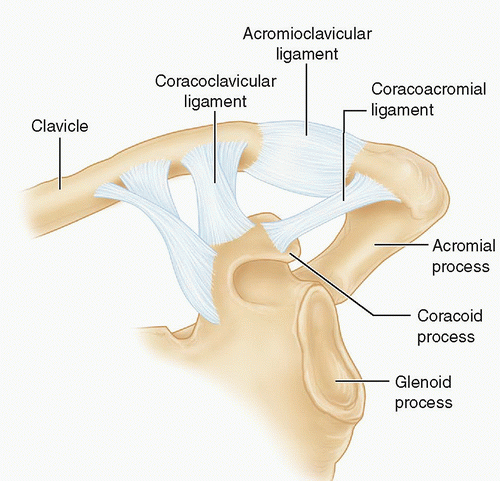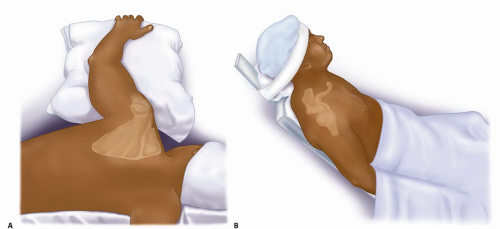Open Reduction and Internal Fixation of Nonarticular Scapular Fractures
Brett D. Owens
Thomas P. Goss
DEFINITION
Nonarticular scapular fractures include fractures of the glenoid neck, scapular spine and body, acromial process, and coracoid process. They account for 90% of scapular fractures.6
Most nonarticular scapular fractures can be treated nonoperatively, including all isolated scapular body-spine fractures.
ANATOMY
The scapula is a flat triangular bone with three processes laterally: the glenoid process, the acromial process, and the coracoid process.
The glenoid process consists of the glenoid fossa, the glenoid rim, and the glenoid neck.
The superior shoulder suspensory complex is a bone and soft tissue ring at the end of a superior and an inferior bony strut (FIG 1). This ring is composed of the glenoid process, the coracoid process, the coracoclavicular ligament, the distal clavicle, the acromioclavicular joint, and the acromial process. The superior strut is the middle third of the clavicle, whereas the inferior strut is the junction of the most lateral portion of the scapular body and the most medial portion of the glenoid neck.1
PATHOGENESIS
Scapular fractures usually are the result of high-energy trauma and have a high rate of associated musculoskeletal and underlying thoracic injuries.5
Fractures of the acromion process may be the result of direct trauma due to its subdermal location, whereas coracoid process fractures may be due to a sudden muscular contraction.4
NATURAL HISTORY
The results of nonoperative treatment of nonarticular scapular fractures generally are good. Nonunion is rare because the area has a rich blood supply. Angular deformities often are well compensated for by the wide range of motion of the glenohumeral joint and scapulothoracic articulation.
PATIENT HISTORY AND PHYSICAL FINDINGS
In addition to the specifics of the injury, it is helpful to obtain an understanding of the functional demands on the extremity. Hand dominance, occupation, and sports participation are all relevant.
A thorough neurovascular examination must be performed and deficits evaluated with angiography and electromyography, as necessary.
A thorough soft tissue examination also is warranted, as wounds may represent an open fracture and warrant exploration. Blisters or swelling may delay surgery.
IMAGING AND OTHER DIAGNOSTIC STUDIES
Nonarticular scapular fractures usually are identified on routine shoulder trauma series radiographs: a true anteroposterior (AP) view of the shoulder with the arm in neutral rotation, a true axillary view of the glenohumeral joint, and a true lateral scapular view. An AP weight-bearing view may be indicated.
Computed tomography (CT) scans and three-dimensional reconstructions can be helpful for identification and classification of fractures owing to the complex bony anatomy in this region. In addition, the bony relationships should be evaluated for evidence of any ligamentous disruption.
DIFFERENTIAL DIAGNOSIS
Nonarticular scapular fractures
Intra-articular scapular fractures
Double disruptions of the superior shoulder suspensory complex including a floating shoulder (ie, glenoid neck fracture with ipsilateral middle third clavicle fracture)
Scapulothoracic dissociation
NONOPERATIVE MANAGEMENT
Most (over 90%) scapular fractures can be treated nonoperatively.
Glenoid fossa and rim fractures may require operative management and are discussed in Chapter 36.
Glenoid neck fractures with more than 40 degrees of angulation in the coronal or sagittal plane or translational displacement of 1 cm or more require surgical management. Anatomic neck fractures (lateral to the coracoid process) are inherently unstable and should also be considered for operative intervention.2
Isolated acromial and coracoid process fractures usually are minimally displaced and can be managed nonoperatively. Significant displacement or fractures in conjunction with other bony and soft tissue injuries to the shoulder girdle may require surgical stabilization.4
SURGICAL MANAGEMENT
Preoperative Planning
Imaging studies should be reviewed and available for reference in the operating room. A draped fluoroscopy unit and competent technician should be available during the surgery.
Positioning
Open reduction with internal fixation (ORIF) of scapular fractures requires wide access to the entire shoulder girdle. The patient may be placed in either the lateral decubitus position (FIG 2A) or in the beach-chair position (FIG 2B), but care must be taken to allow adequate exposure of the entire scapula and clavicle.
Stay updated, free articles. Join our Telegram channel

Full access? Get Clinical Tree










